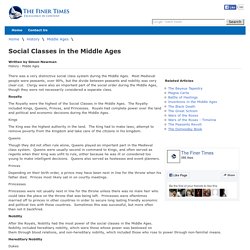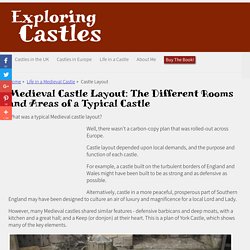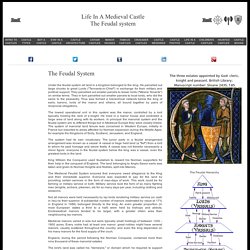

Feudal Society. Social Classes in the Middle Ages. Written by Simon Newman History - Middle Ages There was a very distinctive social class system during the Middle Ages.

Most Medieval people were peasants, over 90%, but the divide between peasants and nobility was very clear-cut. Clergy were also an important part of the social order during the Middle Ages, though they were not necessarily considered a separate class. Royalty. Feudalism and Knights. A fiefdom. Peasant house. Medieval Life - The Manor. Ightham Mote, a 14th-century moated manor house in Kent, photo by Silver149.

Medieval Life - Feudalism and the Feudal System. For more information on counter-intuitive facts on medieval life and the feudal system, see Anthony Esolen’s The Politically Incorrect Guide to Western Civilization.

The feudal system was introduced to England following the invasion and conquest of the country by William I, The Conqueror. The feudal system had been used in France by the Normans from the time they first settled there in about 900AD. It was a simple, but effective system, where all land was owned by the King. The Merchants/Craftsmen/Farmers and Peasants - THE FEUDAL SYSTEM By: F.Anderson. Medieval Castle Layout: A Typical Castle Layout, Explaining Different Areas and Buildings. The Medieval Castle Layout of Farleigh Hungerford Castle So let's look at the layout of an excellent example of a Medieval castle - Farleigh Hungerford castle, in Somerset, UK.

Farleigh Hungerford has many traditional features of Medieval castles. Although it's not a totally perfect example (I struggled to find the 'perfect' one!) , it's still a very typical demonstration of the conventions and features of Medieval castle layout. Farleigh Hungerford Castle was, first and foremost, a grand residence for the Hungerford family.
Here's an image of the castle today taken from Google Earth. Castle Life - The Feudal System. Lords of Medieval Manors exercised certain rights including Hunting and Judicial rights.

The Lord of the Manor was based in the Manor House and from here he conducted the business of the manor. People who worked on the manor included: Bailiff - A Bailiff was a person of some importance who undertook the management of manors Reeve - A Reeve was a manor official appointed by the lord or elected by the peasants Millers - Most manors had windmills or watermills. The right to mill was in the gift of the Lord of The Manor. Servants - Servants were house peasants who worked in the lord's manor house, doing the cooking, cleaning, laundering, and other household chores Serf - Medieval Serfs were peasants who worked his lord's land and paid him certain dues in return for the use of land, the possession but not the ownership of which was heritable. Dues were usually in the form of labour on the lord's land. Three primary elements characterised feudalism: lords, vassals, and fiefs. Romanesque church. The process of urban growth. Contemporary Accounts of the Black Death (Classroom Activity)
The Black Death reached England on 1st August 1348.

The first case was at the port of Melcombe Regis in August, 1348. From Dorset it spread west to Devon, Cornwall and Somerset. The port of Bristol, England second largest town, was very badly hit. It has been estimated that approximately 40% of the town's population died from the disease. It then started moving east. The first symptoms of the Black Death included a high temperature, tiredness, shivering and pains all over the body. The Black Death is, in fact, not one but two related diseases. In some cases bubonic plague becomes concentrated in the lungs and causes symptoms similar to pneumonia.
Doctors could do little to help those suffering from the Black Death. Black Death. The Black Death was a devastating global epidemic of bubonic plague that struck Europe and Asia in the mid-1300s.

The plague arrived in Europe in October 1347, when 12 ships from the Black Sea docked at the Sicilian port of Messina. People gathered on the docks were met with a horrifying surprise: Most sailors aboard the ships were dead, and those still alive were gravely ill and covered in black boils that oozed blood and pus. The Pandemic That Shook London.